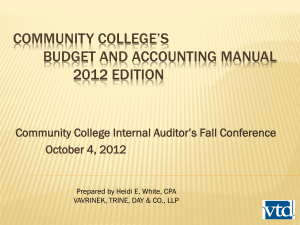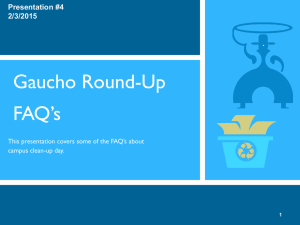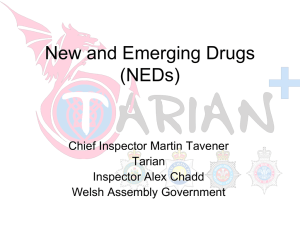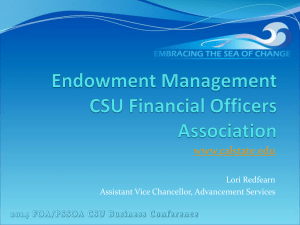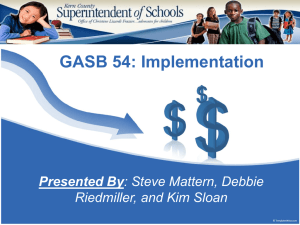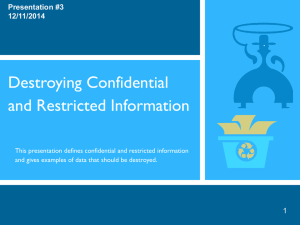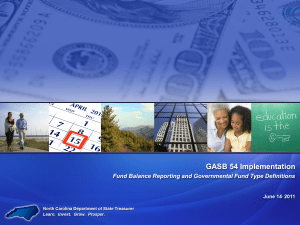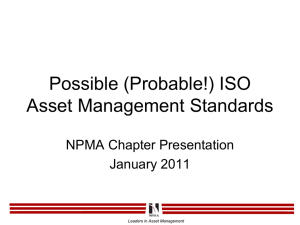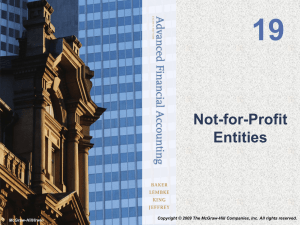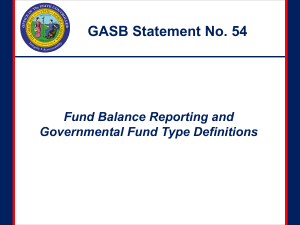Net Asset Classification * Why Is It Important?
advertisement
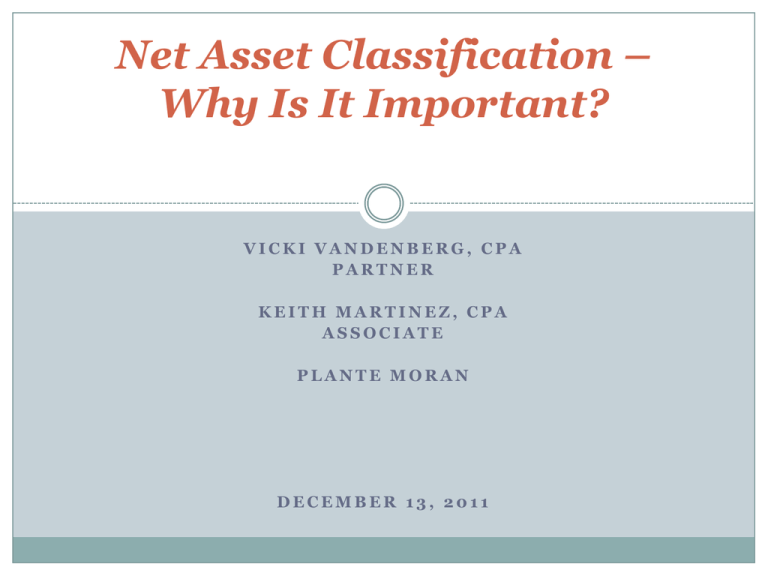
Net Asset Classification – Why Is It Important? VICKI VANDENBERG, CPA PARTNER KEITH MARTINEZ, CPA ASSOCIATE PLANTE MORAN DECEMBER 13, 2011 Agenda Increased scrutiny Reliance on net assets Common errors Classification – FASB Classification – GASB Case studies Meaning to the reader of the statements How to handle an error Recent Public Scrutiny Ohio Senate Finance Chairman Chris Widener $8B state budget deficit $3B in combined reserves for Ohio public colleges and universities Request for tuition increases Shared concern with university presidents and financial officers Reliance on Net Asset Reporting Boards are approving recommendations of management Governance may not understand the different net asset categories Board designated reserves versus unrestricted net assets Common Mistakes Presentation of board designated net assets Treatment of appreciation/depreciation in endowment investments Unspent bond proceeds Undistributed earnings on endowment funds Classification of temporarily restricted or expendable net assets Net Asset Classification - FASB Section 958-210-20 - provides definition of net asset categories Section 958-210-45-9 – describes classification of net assets Section 958-210-55 – provides format of net asset section Net Asset Classifications – FASB cont. Temporarily Restricted Net assets resulting from contributions or other inflows with donor-imposed stipulations that expire by the passage of time or specified use of the funds Usually restricted fund, part of the endowment fund, portion of the plant and student loan fund is closed into temporarily restricted Net Asset Classifications – FASB cont. Permanently Restricted Net assets resulting from contributions or other inflows with donor-imposed stipulations for the funds to be held in perpetuity Even though the fund is permanently restricted, the earnings could be unrestricted depending on the details of the restriction imposed Corpus of the endowment fund and part of the student loan fund is classified in permanently restricted Net Asset Classifications – FASB cont. Unrestricted Net assets that are neither temporarily or permanently restricted by donor-imposed stipulations Generally result from revenues from providing services, unrestricted contributions, and dividends or interest less expenses incurred providing services, raising contributions and performing administrative functions Usually general, auxiliary and most of the plant fund is closed into unrestricted Net Asset Classification – FASB cont. Based on the existence or absence of donor-imposed restrictions Amount of each class must be reported on the face of the statement Nature and amounts of each type (temporarily, permanently) reported on the face or in the notes Designations of net assets can be disclosed on the face of the statements and are classified under unrestricted net assets Net Asset Classification - GASB GASB Statement No. 34, paragraphs 32-37 GASB Comprehensive Implementation Guide, Chapter 7 Net Asset Classification – GASB cont. Net assets should be presented in three components Invested in capital assets, net of related debt Restricted Unrestricted Net Asset Classifications – GASB cont. Invested in Capital Assets – net of related debt Represents the balance of net assets that are invested in property and equipment Includes restricted capital assets Capital Assets less long term debt plus bond issuance costs plus unspent bond proceeds Net Asset Classifications – GASB cont. Restricted Net Assets Externally imposed by creditors, grantors, contributors Imposed by law through constitutional provision or enabling legislation Must distinguish between expendable and nonexpendable Net Asset Classifications – GASB cont. Restricted – Expendable Similar to temporarily restricted (FASB) Restricted by a third party for a specific use Examples include unspent grants and contributions Restricted – Nonexpendable Similar to permanently restricted (FASB) Required to be retained in perpetuity Endowment corpus Net Asset Classification – GASB cont. Unrestricted Net Assets Consist of net assets that do not meet the definition of the other two categories No restrictions are imposed Includes designated Net Asset Classification – GASB cont. Designations of net assets cannot be disclosed on the face of the statements Should not be reported on the face of the statements Include in MD&A or footnotes Net Asset Case Study #1 Board approved transferring surplus over $100,000 from general fund to endowment fund How do you report? Answer: The $100,000 is considered part of board designated net assets – if GASB can report in footnotes or MD&A, if FASB, can show as a component of unrestricted Net Asset Case Study #2 A portion of the endowment fund is considered quasi-endowed due to no donor restriction – where are earnings reported? Answer: The earnings are reported as unrestricted. Further analysis should be done to determine if they should also be considered board designated Net Asset Case Study #3a An endowment fund was underwater in prior year by $50,000. This year the unrealized gains on the fund are $75,000 – how do you report the current year gain (FASB example)? Answer: $50,000 of the unrealized gains are reported as unrestricted since the under water is to be repaid. The remaining $25,000 is reported as temporarily restricted until appropriated for expenditure in accordance with terms of the endowment fund. Net Asset Case Study #3b An endowment fund was underwater in prior year by $50,000. This year the unrealized gains on the fund are $75,000 – how do you report the current year gain (GASB example)? Answer: $50,000 of the unrealized gains are reported as a recapture of nonexpendable since the under water is to be repaid. The remaining $25,000 is reported as expendable until appropriated for expenditure in accordance with terms of the endowment fund. Net Asset Case Study #4 In accordance with a donor endowment challenge for every dollar contributed up to $5,000 the Board will match the endowment gift. How do you report the match (FASB)? Answer: If a donor contributes to an endowment fund by contributing $5,000 those earnings are reported as permanently restricted contributions. The Board approved match is recorded as a net asset transfer moving from unrestricted to permanently restricted. Net Asset Case Study #5 Recognition of increase in market value on University endowment fund, where reported? Answer: The increase in market value is treated similar to interest and dividends and is reported as restricted expendable absent any donor restrictions. Net Asset Case Study #6 Market value of endowment fund falls below value of original gift, where is the unrealized loss reported? Answer: GASB - The unrealized loss should be recorded against restricted expendable however, a deficit in restricted net assets can not be shown (excess would go against restricted nonexpendable) FASB – The unrealized loss should be recorded against restricted however, a deficit in restricted net assets can not be shown (excess would go against unrestricted) What does it mean to the reader of the FS? Provides the financial statement reader with… What assets have external purpose restrictions What assets are spoken for (designated) What assets are available for use How to Handle an Error? Depends on the nature of the error Between restricted and unrestricted Between restricted expendable and nonexpendable Depends on materiality Percentage of total assets Percentage of net assets Percentage of total revenue How to Handle an Error? Financial statement treatment Adjust the current year presentation Prior period adjustment Classification of error/finding Control deficiency Significant deficiency Material weakness Thank You! Vicki VanDenBerg vicki.vandenberg@plantemoran.com 269.567.4618 Keith Martinez keith.martinez@plantemoran.com 614.222.9086
